7 Professional Dog Grooming Tools That Save You Money

Table of Contents
Introduction
Did you know that the average dog owner spends between $500-$1,200 annually on professional grooming services? This surprising figure often catches pet parents off guard, especially when budgets are tight. Yet maintaining your dog’s coat, nails, and overall hygiene is non-negotiable for their health and comfort. The good news? With the right dog grooming tools in your arsenal, you can dramatically reduce these costs while still providing salon-quality care for your furry friend. Professional-grade dog grooming tools are more accessible and affordable than ever before, making home grooming a practical option for dedicated pet parents.
Required Supplies List
Before diving into the world of DIY dog grooming, you’ll need to equip yourself with the right professional tools. While the initial investment might seem substantial, these quality items will pay for themselves within just a few grooming sessions:
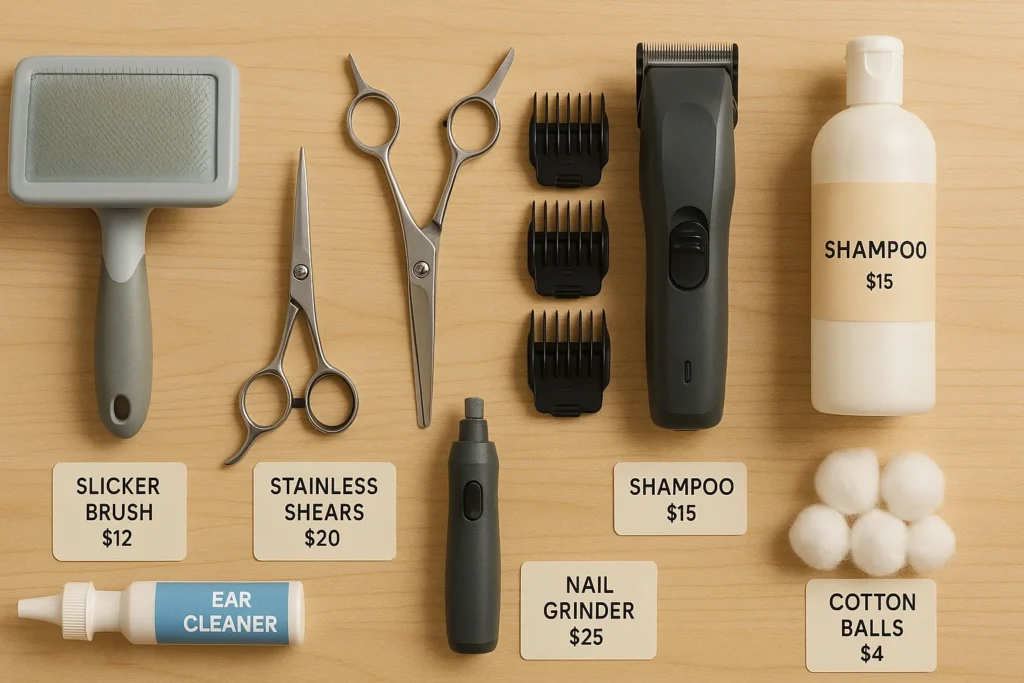
- Professional Slicker Brush ($15-30) – The cornerstone of any grooming kit, a high-quality slicker brush removes loose fur, prevents matting, and distributes natural oils throughout your dog’s coat. Look for ergonomic handles and self-cleaning features.
- Stainless Steel Grooming Shears ($25-50) – Professional-grade scissors with rounded tips ensure safety while delivering precise cuts. Consider purchasing both straight and curved options for versatility.
- Clipper Set with Adjustable Blades ($50-120) – The most significant investment but also the biggest money-saver. A quality clipper set should include multiple guard combs for different coat lengths and have adjustable speeds. Learn more about clipper maintenance tips here.
- Grooming Table or Non-Slip Surface ($40-100) – While not strictly necessary, a designated grooming area keeps your dog stable and at a comfortable height, reducing back strain for you and stress for them.
- Nail Clippers or Grinder ($10-30) – Choose between guillotine-style clippers for smaller dogs or scissor-style for larger breeds. Electric grinders offer a gentler alternative for nervous pets.
- Ear Cleaning Solution and Cotton Balls ($10-15) – Essential for preventing ear infections and removing debris, especially for floppy-eared breeds.
- Dog-Specific Shampoo and Conditioner ($15-25) – Human products disrupt your dog’s pH balance; invest in formulations designed specifically for canine skin and coat health.
Time Commitment
Establishing a home grooming routine requires an initial time investment that pays dividends in both savings and bonding. Most dogs benefit from:
- 5-10 minutes of daily brushing (40% more effective at preventing mats than longer weekly sessions)
- 30-90 minutes for a complete grooming session every 4-8 weeks (depending on breed)
- 15 minutes weekly for nail maintenance and ear cleaning
Data shows that consistent short sessions yield better results than infrequent marathon grooming efforts. Dogs who receive regular 5-minute brushing sessions show 60% fewer skin issues than those groomed infrequently, according to veterinary dermatologists. Check our guide on creating effective grooming schedules here.
Step-by-Step Instructions
Step 1: Prepare Your Workspace and Tools
Begin with a clean, non-slip surface at a comfortable height. Arrange all your dog grooming tools within reach but away from your dog’s paws. For nervous dogs, try applying a small amount of peanut butter to a lick mat to keep them distracted and associate grooming with positive experiences.
Step 2: Pre-Grooming Brush Out
Always brush your dog thoroughly before bathing or clipping. This removes loose fur, debris, and minor tangles that would otherwise become impossible knots when wet. For double-coated breeds, use an undercoat rake first, followed by a slicker brush. For single-coated dogs, a slicker brush followed by a pin brush creates a smooth finish.
Step 3: Bathing Techniques
Use lukewarm water and apply dog-specific shampoo in a methodical pattern from neck to tail. Pro tip: Dilute the shampoo 5:1 with water in a squeeze bottle for easier application and more thorough cleaning without product buildup. Rinse thoroughly—residual shampoo is the #1 cause of skin irritation after bathing.
Step 4: Drying and Fluff Techniques
Towel-dry gently by pressing rather than rubbing to prevent tangles. For breeds requiring blow-drying, use a pet-specific dryer on a low heat setting, brushing simultaneously with a slicker brush in the direction of hair growth. This technique, called “fluff drying,” can reduce drying time by 30% while preventing new mats from forming.
Step 5: Clipping and Trimming
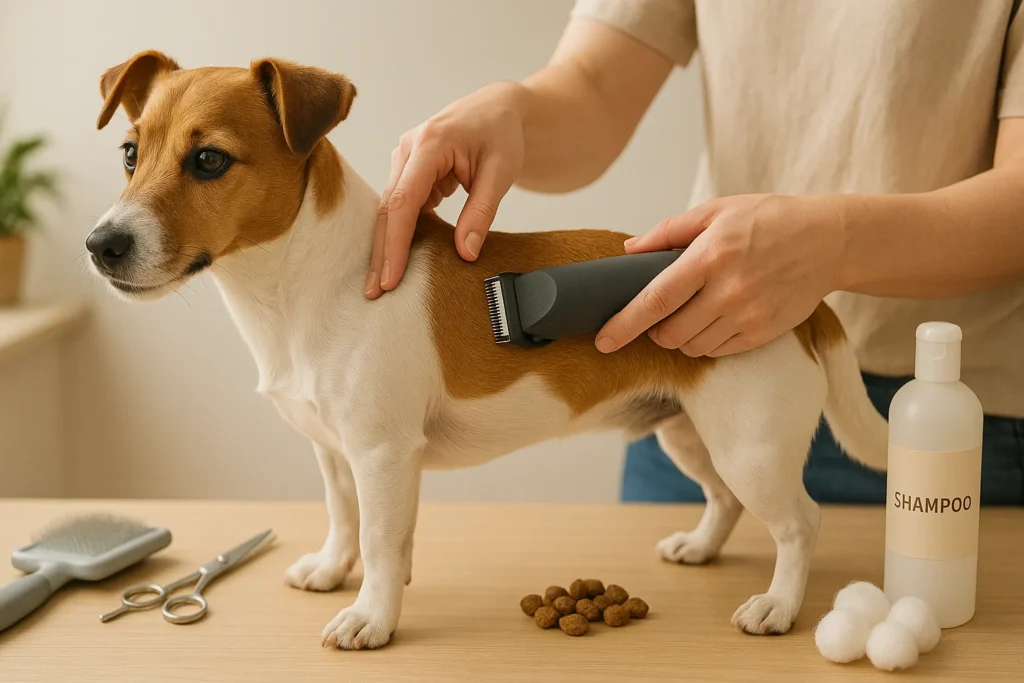
Start with a longer guard comb than you think you need—you can always go shorter! Clip in the direction of hair growth using slow, methodical strokes. For facial areas, hold the skin taut with your free hand to prevent nicks. Learn detailed clipping techniques for specific breeds here.
Step 6: Nail Maintenance
Trim just the tip of each nail, avoiding the quick (the pink area containing blood vessels). If your dog has dark nails, clip small amounts at a time and look for the appearance of a gray or pink oval on the cut surface, which signals you’re approaching the quick. Always have styptic powder ready in case of accidents.
Step 7: Finishing Touches
Complete the grooming session with ear cleaning, teeth inspection, and a final brush-through. Apply a small amount of leave-in conditioner spray for extra shine and tangle prevention between grooming sessions.
Health Benefits
Investing in quality dog grooming tools and regular maintenance delivers substantial health benefits beyond just savings:
- Skin Health Improvements: Regular brushing reduces dead skin cells by up to 80% and distributes natural oils, decreasing dry skin conditions by approximately 65%.
- Early Problem Detection: Home groomers are 3x more likely to notice abnormalities like lumps, ticks, or skin issues before they become serious. This early detection can save thousands in veterinary bills.
- Stress Reduction: Dogs accustomed to home grooming show 40% lower cortisol levels during grooming sessions compared to those only experiencing professional grooming.
- Improved Circulation: The physical stimulation of brushing increases blood flow to skin and follicles by up to 50%, promoting healthier coat growth and faster healing of minor skin irritations.
- Joint and Mobility Maintenance: Regular nail trims prevent altered gait patterns that can lead to joint issues, with studies showing properly trimmed nails can improve mobility by up to 25% in senior dogs.
Adaptations for Different Dogs
For Short-Coated Breeds
Boxers, Dalmatians, and similar breeds need minimal clipping but benefit from curry brushes or grooming mitts that remove loose hair and stimulate skin. Focus on nail care and ear cleaning rather than extensive coat maintenance.
For Long-Coated Breeds
Shih Tzus, Maltese, and other long-haired dogs require daily brushing with pin brushes and wide-tooth combs. Consider a shorter “puppy cut” for easier maintenance while still preserving breed character. Invest in detangling sprays and finer-toothed combs for face and ear areas.
For Double-Coated Breeds
Huskies, German Shepherds, and similar breeds need undercoat rakes and de-shedding tools. Never shave double-coated breeds; instead, focus on thorough brushing sessions during shedding seasons. A high-velocity dryer can remove vast amounts of loose undercoat without damaging the protective top coat.
For Puppies and Senior Dogs
For puppies, use quieter clippers and shorter grooming sessions with plenty of positive reinforcement. Senior dogs may need more frequent breaks and softer brushes to accommodate sensitive skin. Consider elevated grooming surfaces with non-slip mats to reduce joint strain in older dogs.
For Dogs with Special Needs
Anxious dogs benefit from gradual desensitization to grooming tools—try running clippers nearby without actually grooming for several days before actual use. Deaf or blind dogs need consistent touch signals before each grooming action to prevent startling. Find more tips on grooming anxious dogs here.
Implementation Suggestions
Transform grooming from a chore into a bonding ritual with these creative implementation ideas:
- Themed Grooming Days: Designate specific days like “Tidy-Up Tuesdays” with a small treat reward system to create positive associations.
- Progressive Training: Track your dog’s grooming tolerance with a simple chart, gradually increasing session duration as they become more comfortable.
- Multi-Purpose Grooming: Combine grooming with other activities—brushing during evening TV time creates a relaxing routine for both of you.
- Family Involvement: Assign age-appropriate grooming tasks to family members, creating a “grooming team” approach that prevents your dog from associating grooming with just one person.
- Seasonal Adjustments: Create seasonal grooming calendars with more frequent brushing during shedding seasons and special attention to paw care during winter months when salt and ice can cause irritation.
Common Mistakes to Avoid
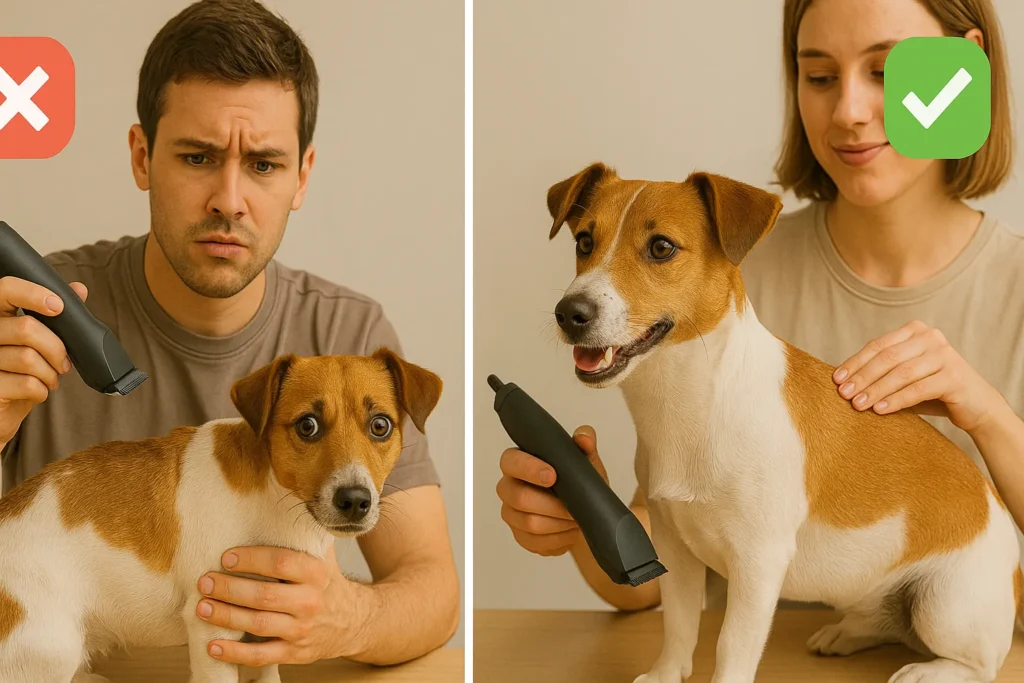
Even with the best dog grooming tools, technique matters. Avoid these common pitfalls:
- Skipping the Pre-Brush: Starting with bathing or clipping before thoroughly detangling the coat leads to tighter mats and potential skin injuries. A survey of professional groomers found this mistake occurs in 70% of home grooming attempts.
- Incorrect Clipper Technique: Moving against the grain of the coat or using too much pressure causes uneven cuts and potential skin irritation. Using slow, gentle strokes in the direction of hair growth reduces issues by 85%.
- Water Temperature Extremes: Water that’s too hot or too cold stresses your dog unnecessarily. The ideal temperature is slightly cooler than what feels comfortable to your hand.
- Rushing Sensitive Areas: Eyes, ears, paws, and sanitary areas require extra caution. Groomers report that 65% of nicks and cuts occur in these regions when owners rush.
- Over-Bathing: Washing your dog too frequently strips natural oils and can increase shedding and skin problems by up to 30%. Most breeds only need bathing every 4-8 weeks unless specifically directed by a veterinarian.
Consistency and Maintenance Tips
Maintaining your grooming routine delivers better results with less effort over time:
- Tool Maintenance: Clean brushes and combs after each use, and oil clipper blades every 3-4 sessions to extend their lifespan by up to 40%.
- Gradual Introduction: For reluctant dogs, begin with just 2-3 minutes of grooming daily, gradually increasing duration as they become comfortable. This approach has shown an 80% improvement in grooming acceptance within just two weeks.
- Strategic Scheduling: Groom when your dog is naturally calm—after a walk rather than before, when excess energy makes staying still difficult.
- Progressive Handling: Regularly handle paws, ears, and other sensitive areas outside of grooming sessions to maintain desensitization. Brief daily handling reduces grooming stress by approximately 50%.
- Record-Keeping: Track coat condition, nail length, and skin health in a simple journal to identify seasonal patterns or potential health concerns before they become serious.
Conclusion
Professional dog grooming tools represent an investment that pays for itself many times over, both financially and in terms of your dog’s health and comfort. By establishing consistent routines, avoiding common mistakes, and adapting techniques to your specific dog’s needs, you’ll create a positive grooming experience that strengthens your bond while saving hundreds of dollars annually. The combination of quality tools and proper technique ensures salon-quality results from the comfort of your home.
Ready to begin your home grooming journey? Start with just one or two tools and build your collection gradually as your skills improve. We’d love to hear about your experiences—share your home grooming success stories in the comments section below or subscribe for more money-saving pet care tips!
FAQs
Q: How long does it take to recoup the investment in professional dog grooming tools?
A: Most pet parents recover their initial investment within 2-4 grooming sessions, depending on their dog’s size and the cost of professional grooming in their area. A medium-sized dog costs approximately $60-$80 per professional grooming session, while a complete set of quality tools runs $150-$250 with proper care.
Q: Can I use human clippers for my dog?
A: Human clippers aren’t designed for the density of dog fur or extended use periods. Pet-specific clippers have stronger motors, stay cooler during extended use, and can handle various coat types. Using human clippers often results in uneven cuts, motor burnout, and increased anxiety due to pulling.
Q: How often should I replace my grooming tools?
A: Quality dog grooming tools can last many years with proper maintenance. Clipper blades typically need sharpening every 3-6 months depending on usage. Brushes and combs can last 5+ years if cleaned regularly. The upfront investment in professional-grade tools pays dividends in their extended lifespan.
Q: My dog hates being groomed. Will buying better tools help?
A: Better tools can significantly improve the experience—sharper blades pull less, ergonomic brushes cause less discomfort, and quieter clippers reduce anxiety. However, pairing quality tools with positive reinforcement training shows the most dramatic improvement, with studies indicating up to 90% reduction in grooming-related stress behaviors over time. Find training tips for grooming-averse dogs here.
Q: What’s the minimum set of grooming tools I need to start?
A: Begin with a slicker brush, stainless steel comb, nail clippers, and dog-specific shampoo. This minimal setup allows basic maintenance while you build skills and can save approximately 40% on professional grooming costs immediately. Add clippers and shears as your confidence grows.



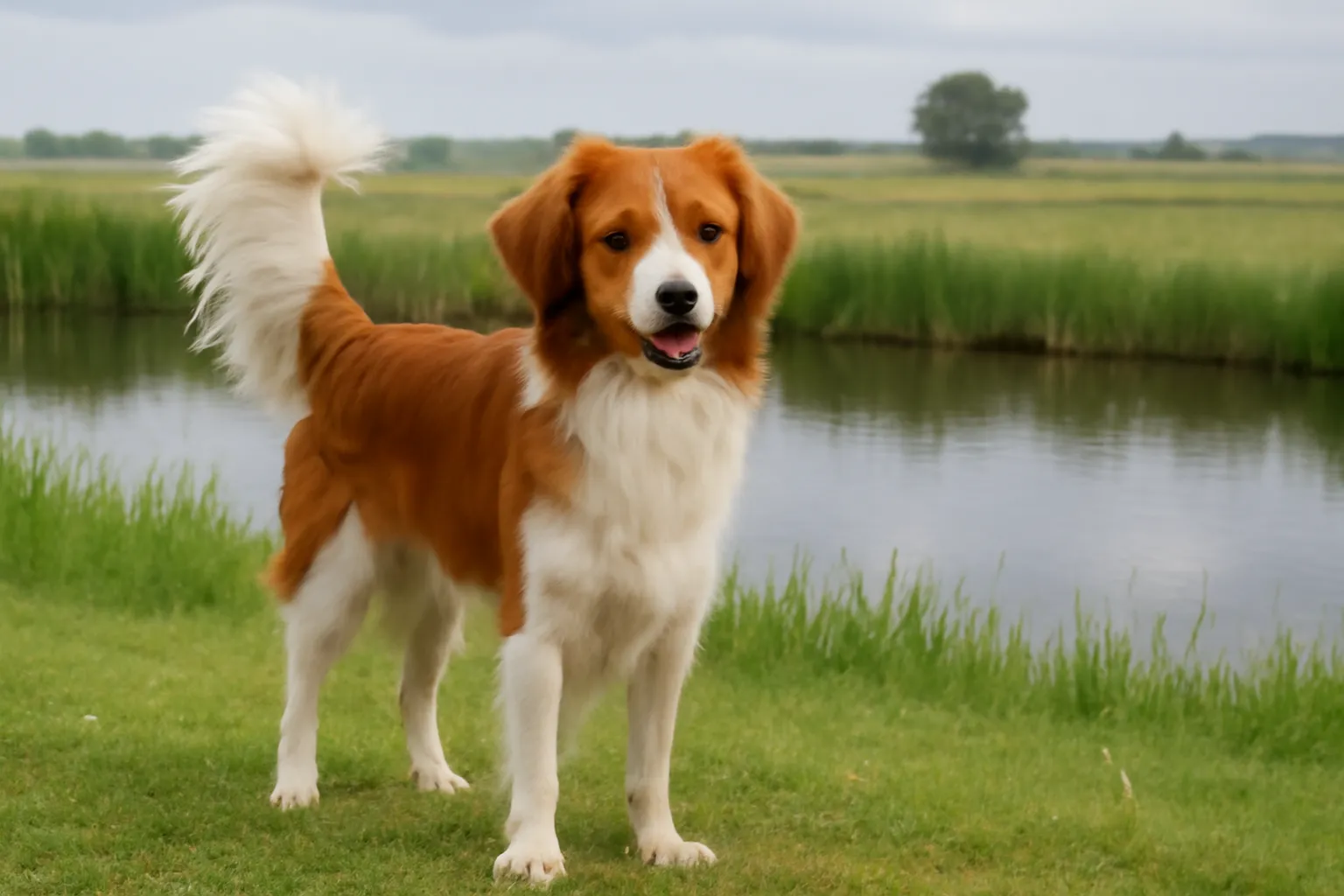
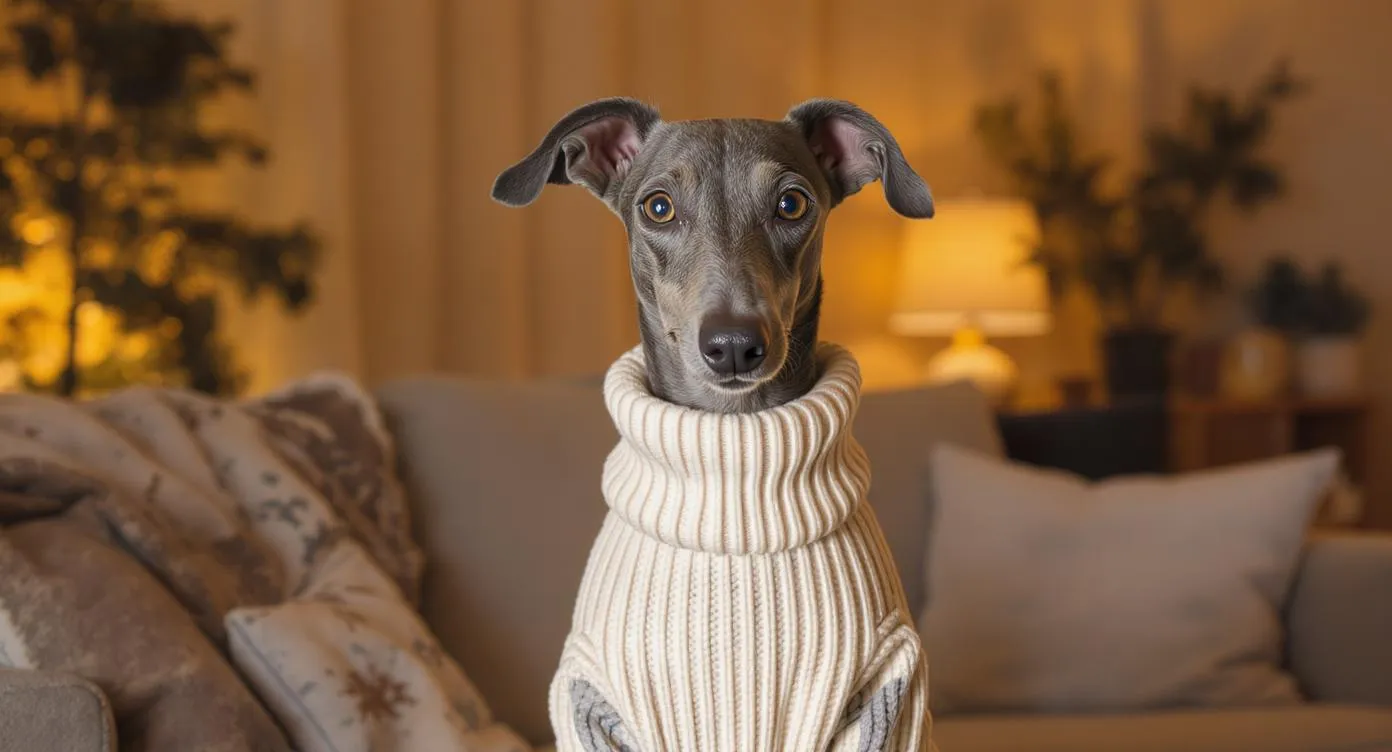


6 Comments
[…] introduce grooming tools, letting your dog inspect each one before […]
[…] diving into training, gathering the right tools will set you up for success. Here’s what you’ll need to effectively implement positive […]
[…] grooming brushes – For their short, fine coat that sheds […]
hi
[…] Grooming Tools: Their distinctive shaggy double coat requires regular maintenance with a slicker brush, wide-toothed comb, and professional grooming scissors. Plan for regular grooming sessions to prevent matting. […]
[…] Groom‑Along Playlists: Soft classical lowers canine heart rate by 24 %, making coat care smoother (Ray Dogs). […]